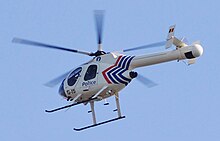Tail rotor
This article needs additional citations for verification. (October 2008) |

The tail rotor is a smaller
Tail rotors are simpler than main rotors since they require only collective changes in pitch to vary thrust. The pitch of the tail rotor blades is adjustable by the pilot via the anti-torque pedals, which also provide directional control by allowing the pilot to rotate the helicopter around its vertical axis. Its drive system consists of a
Design
The tail rotor system rotates airfoils, small wings called blades, that vary in pitch in order to vary the amount of thrust they produce. The blades most often utilize a
The tail rotor is powered by the helicopter's main power plant, and rotates at a speed proportional to that of the main rotor. In both piston and turbine powered helicopters, the main rotor and the tail rotor are mechanically connected through a
Reliability and safety

The tail rotor and the systems that provide power and control for it are considered critically important for safe flight. As with many parts on a helicopter, the tail rotor, its transmission, and many parts in the drive system are often life-limited, meaning they are arbitrarily replaced after a certain number of flight hours, regardless of condition. Between replacements, parts are subject to frequent inspections utilizing visual as well as chemical methods such as fluorescent penetrant inspection to detect weak parts before they fail completely.
Despite the emphasis on reducing failures, they do occasionally occur, most often due to hard landings and
The tail rotor itself is a hazard to ground crews working near a running helicopter. For this reason, tail rotors are painted with stripes of alternating colors to increase their visibility to ground crews while the tail rotor is spinning.
Alternative technologies
There have been three major alternative designs which attempt to solve the shortcomings of the tail rotor system.
The first is to use an

McDonnell Douglas developed the NOTAR (NO TAil Rotor) system, which eliminates having any rotating parts out in the open. The NOTAR system uses a variable pitch ducted fan driven by the helicopter's powerplant, but the ducted fan is mounted inside the fuselage ahead of the tail boom, and the exhaust passes through the tail boom to the end, where it is expelled out one side. This creates a boundary layer which causes the downwash from the main rotor to hug the tail boom according to the Coandă effect. This creates a force which cancels out the main rotor torque and provides directional control. The advantages of the system are similar to the Fenestron system discussed above.
There are at least four ways to eliminate the necessity of a tail rotor altogether :
- CH-47 Chinook.
- The fixed wings. This allows the rotors to serve instead as propellerswhen flying forward at full speed.
- Coaxial. Other designs such as the coaxial counter-rotating main rotors, which means that both rotors spin around the same axis but in opposite directions. The complexity of any dual main rotor system almost invariably requires the addition of a fly-by-wireflight control system, which increases costs drastically.
- Intermeshing rotors also turn in opposite directions, but the blades rotate into the gaps between the opposing blades so the rotors can intersect each other's path without colliding. Invented by Anton Flettner and used in Flettner Fl 282,[2] Kaman HH-43 Huskie, and Kaman K-MAX.
- Tip jet. Another way to eliminate the effect of torque created by the rotorwing is by mounting the engine on the tips of the rotorwing rather than inside the helicopter itself; this is called a tip jet. One example of a helicopter using such a system is the NHI H-3 Kolibrie, which had a ramjet on each of the two wingtips, and an auxiliary power unit to spin up the rotor before starting the ramjets. Another example would be the Fairey Rotodyne. Also, unpowered rotors used in autogyro, gyrodyne, and derived concepts do not need a tail rotor either, although nearly all models that utilize this concept of propulsion do need a second propeller in one way or another to drive them forward to begin with.
See also
- Piasecki X-49
- Loss of tail-rotor effectiveness
References
- ^ Dave Jackson. "Flight Dynamics - Definitions & Algorithms Archived 2016-11-01 at the Wayback Machine" UniCopter, 29 January 2013. Accessed: 19 November 2013.
- ISBN 978-1-58980-700-6.
- ISBN 1-56027-404-2. FAA-8083-21.
